Exhibition highlights cultural imprint of Maritime Silk Road
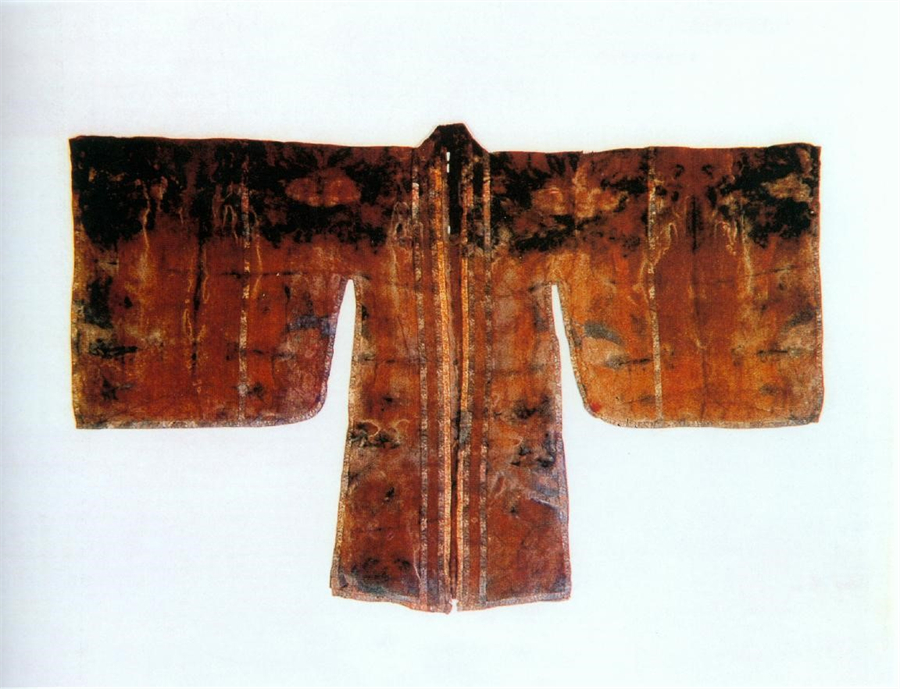
Photo shows a wide-sleeve long robe displayed at an exhibition featuring the cultural imprint of the Maritime Silk Road held at Fujian Museum in Fuzhou, southeast China's Fujian province. [Photo courtesy of Fu Qisheng]
The year 2023 marks the 10th anniversary of the Belt and Road Initiative (BRI). Against this backdrop, Fujian Museum in Fuzhou, southeast China's Fujian province, kicked off an exhibition on the cultural imprint of the Maritime Silk Road in May.
The exhibition is planned to run from May to August. By exhibiting cultural relics, historical materials, and pictures, it aims to highlight the cultural imprint of the Maritime Silk Road and underline the historical and practical significance of harmonious coexistence and the building of a community with a shared future for mankind.
The Maritime Silk Road bore witness to the communication and exchanges between the Chinese nation and the outside world on the vast blue ocean. It left to mankind rich cultural heritage, which reflects the diversified and interactive civilizations of the world like a kaleidoscope.
Since the BRI was proposed by China, the Silk Road-theme exhibition has become a hotspot in the cultural industry.
In 2013, Fujian Museum took the lead in holding a joint exhibition of cultural relics featuring the Maritime Silk Road in collaboration with relevant authorities. The exhibition was held in more than 20 countries and regions as well as the United Nations (UN) headquarters, arousing enthusiastic response.
Today, just in time, Fujian Museum is staging another exhibition featuring the Maritime Silk Road.
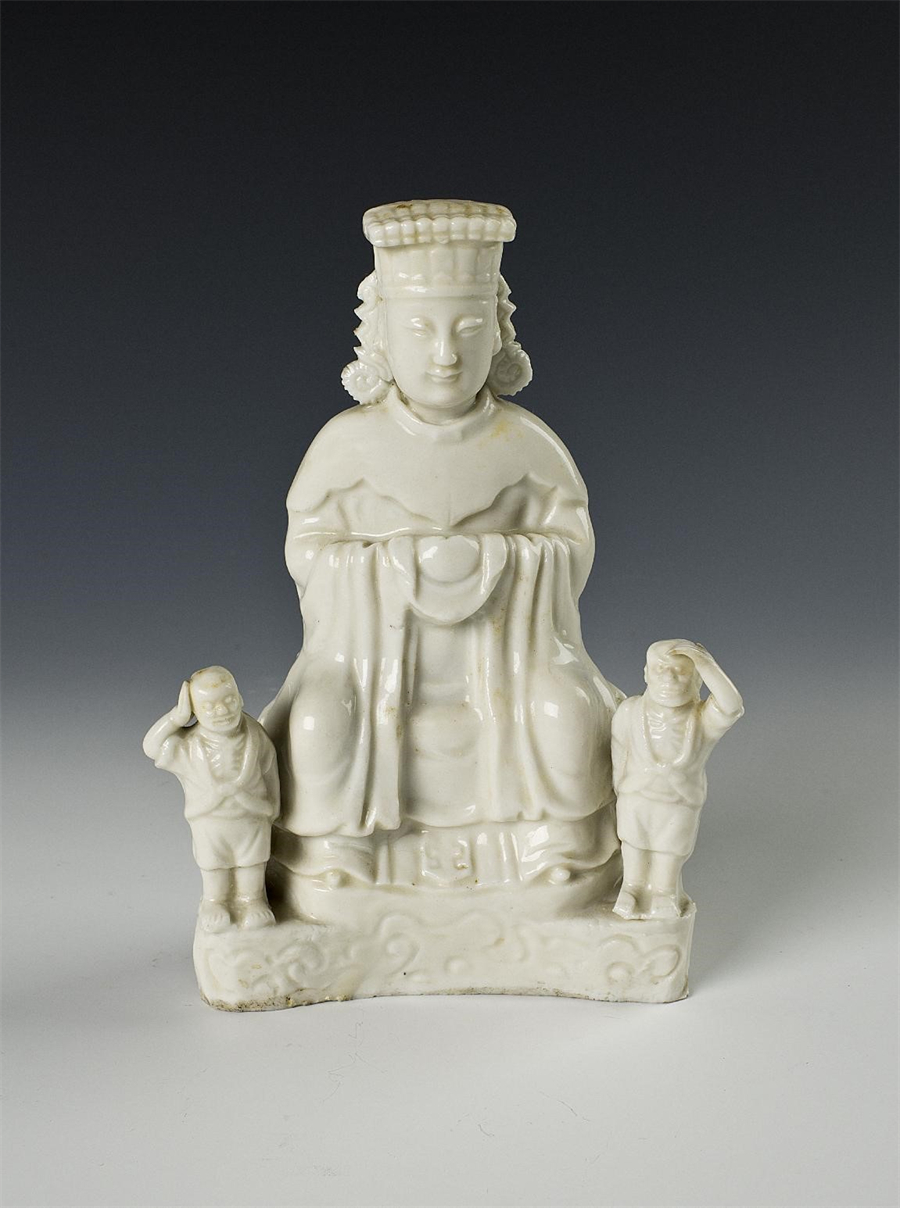
Photo shows a sitting statue of Chinese sea goddess Mazu made of white-glazed porcelain, which is displayed at an exhibition featuring the cultural imprint of the Maritime Silk Road held at Fujian Museum in Fuzhou, southeast China's Fujian province. The statue was made in a kiln in Dehua county, Quanzhou, southeast China's Fujian province, in China's Ming Dynasty (1368-1644). [Photo courtesy of Fu Qisheng]
Facilitating trade in porcelain, silk, tea, and spices, the Maritime Silk Road also served as a path to cultural exchanges, mutual benefit, peace and friendship for various countries along the road.
The ongoing exhibition at Fujian Museum displays 295 pieces (sets) of cultural relics in 35 museums across China, including important archaeological finds. The exhibits represent essences selected from a large number of heritage resources to restore the trade, people-to-people and cultural exchanges along the Maritime Silk Road from different perspectives.
The exhibition highlights the historical scenes and cultural connotations of exchanges and mutual learning among different civilizations. The area is divided into four sections focusing on distinctive topics, namely China's maritime history, trade in goods, overseas relics in China, and cultural integration.
The section featuring China's maritime history serves as the beginning part of the exhibition.
According to ancient books, during China's Han Dynasty (202 B.C.-A.D. 220), Chinese officials and merchants set sail from Xuwen county in south China's Guangdong province and Hepu county in south China's Guangxi Zhuang autonomous region, with gold and silk fabrics to ancient countries in Southeast Asia and South Asia to trade for pearls, glass beads, and other exotic products. It is widely believed as one of the signs of the formation of the Maritime Silk Road.
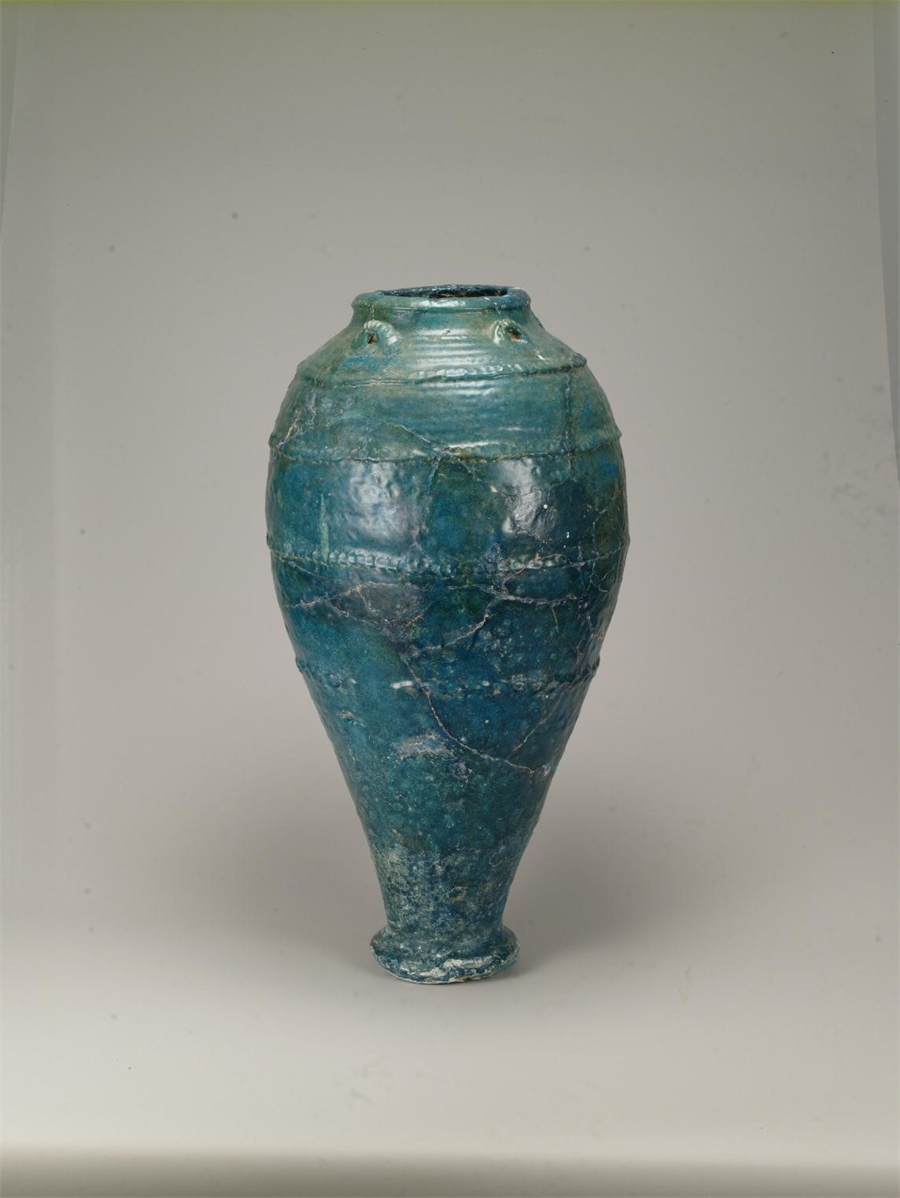
Photo shows a peacock blue-glazed pottery bottle displayed at an exhibition featuring the cultural imprint of the Maritime Silk Road held at Fujian Museum in Fuzhou, southeast China's Fujian province. [Photo courtesy of Fu Qisheng]
A lot of archaeological discoveries serve as new evidence for the Maritime Silk Road, such as the cultural relics from West Asia unearthed in ancient tombs of the Han Dynasty in Hepu county, the ancient port site of the starting point of Chinese monk Jianzhen's sixth voyage to Japan during China's Tang Dynasty (618-907) - the Huangsipu Site, and the Nanhai No. 1 shipwreck dating back to China's Southern Song Dynasty (1127-1279).
This section has put on display relevant cultural relics to depict three major historical events in China's maritime history: Emperor Wu of the Han Dynasty dispatching ships and envoys from Hepu and Xuwen to foreign countries, Chinese envoys' missions to ancient state Goryeo during China's Song Dynasty (960-1279), and the famous Chinese navigator Zheng He's voyages to the Western Seas during China's early Ming Dynasty (1368-1644).
Among the exhibits in this section, the gold ingots housed by the Hubei Provincial Museum are displayed, which date back to the reign of Emperor Yongle of the Ming Dynasty. The exhibits, engraved with inscriptions of purchase records from the West, are tangible evidence of Zheng He's voyages to the Western Seas.
The exhibition section for trade in goods mainly focuses on porcelain, silk and tea, three categories of exports from China in ancient times representing the influence of Chinese civilization overseas.
Porcelain has played an important role in trade along the Maritime Silk Road. The porcelains exhibited in this section include celadon porcelain wares made in the famous Yue kilns and Longquan kilns in east China's Zhejiang province, white porcelain found in kilns in north China's Hebei province, multi-colored porcelain wares such as the tri-colored glazed pottery of the Tang Dynasty, and blue and white porcelains of different styles.
A wide-sleeve long robe found in the tomb of Huang Sheng, a girl who lived in the Southern Song Dynasty (1127-1279) in Fuzhou, is on display in this exhibition section. The tomb is praised as a treasury of silk in the Southern Song Dynasty for its numerous and diverse silk fabrics unearthed.
Fujian's silk fabrics manufacturing industry embraced unprecedented prosperity during the Song Dynasty. The decoration techniques including adorning fabrics with gold, colored drawing, and embroidery were widely used to beautify clothes.
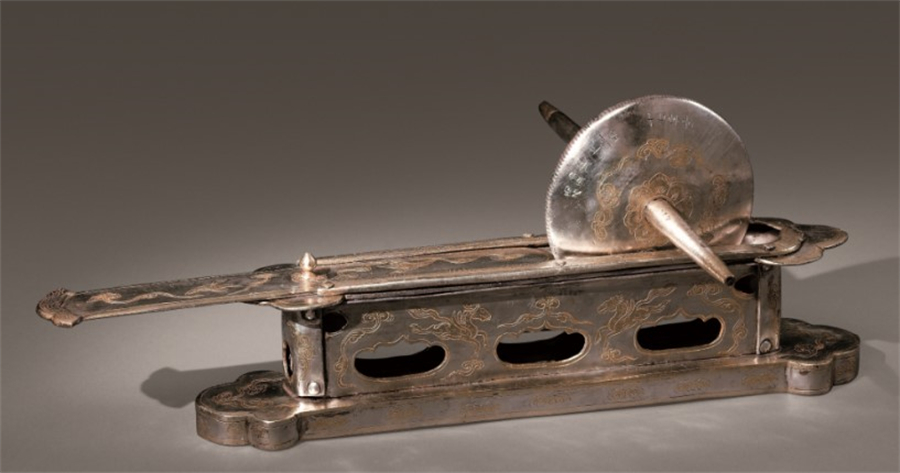
Photo shows a silver tea roller displayed at an exhibition featuring the cultural imprint of the Maritime Silk Road held at Fujian Museum in Fuzhou, southeast China's Fujian province. [Photo courtesy of Fu Qisheng]
Traces of such techniques have also been found in silk fabrics unearthed in China's neighboring countries, which can fully prove Fujian's position as one of the major production bases of silk exports in the Song Dynasty.
Various kinds of tea sets from the Tang and Song dynasties are also shown in this section, including a glass saucer and teacup as well as a silver tea roller discovered in the underground palace in Famen Temple in northwest China's Shaanxi province. The tea roller belonged to Emperor Xizong of the Tang Dynasty, who used it before ascending the throne.
The third exhibition section featuring imported goods from ancient China manifests the inclusiveness of the Chinese civilization. Exhibits include such cultural relics as imported gem ornaments and glass artifacts unearthed from Guangxi, Hunan and Fujian provinces.
Among these exhibits, a peacock blue-glazed pottery bottle from the period of the Five Dynasties and Ten Kingdoms (907-979) is the most precious treasure of Fujian Museum. It is so far the best-preserved peacock blue-glazed ware unearthed in China.
The large pottery bottle is shaped like an olive and evenly covered with blue glaze on its outer surface, conveying a sense of exotic beauty. Experts believe that this pottery ware was likely imported from ancient Persian regions in West Asia.
Various censers and spices are also exhibited in this section. Besides, a special experience zone has been set up through joint efforts of Fujian Museum and Fujian University of Traditional Chinese Medicine, in a bid to create an interactive experience for visitors.
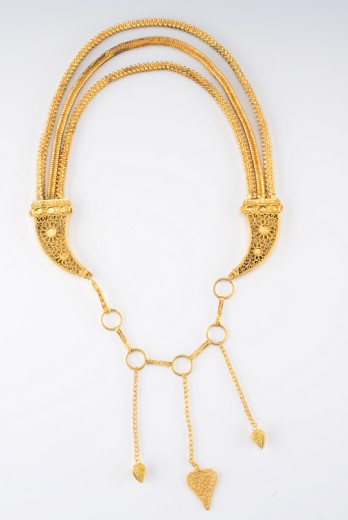
Photo shows a gold necklace in China's Song Dynasty (960-1279). [Photo courtesy of Fu Qisheng]
The last section of the exhibition features the integration of diverse cultures. A white-glazed sitting statue of Chinese sea goddess Mazu made in a kiln in Dehua county during the Ming Dynasty is rather representative of the cultural relics exhibited.
The statue is made of white and delicate porcelain and a bright and smooth layer of glaze, with the glaze sparkling with a slight yellow tinge. It depicts the scene of Mazu sitting upright in a grand gown and with a square flat-topped crown on her head, vividly showing the sea goddess' solicitude for people making a living on the sea.
White porcelains produced by kilns in Dehua enjoyed great popularity in the Ming and Qing dynasties. They were sold to regions as far as Europe.
The Maritime Silk Road is old and yet still vibrant. It is a route on the sea that has helped improve people's well-being to create a better life, as well as a link that has enhanced exchanges and mutual learning among different civilizations.
Today, new cultural connotations are being injected into the ancient Maritime Silk Road.
By showing the road's historical and practical significance through relics and storytelling, the exhibition on the cultural imprint of the Maritime Silk Road has unfolded a scroll of harmonious coexistence, common understanding and mutual appreciation between the Chinese civilization and civilizations of various countries around the world.
Fu Qisheng is the curator of Fujian Museum and vice president of the Chinese Museums Association
























